Back to device_1
 -- Guide to Ridge Route
-- Guide to Ridge Route
DEVICE_2
Interconnected devices become a new device

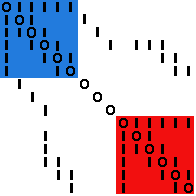
LIMITATION: Notation used with device_1 suggests structural forms that cannot be interpreted on that device.
The two color blocs in the adjacent image have the same form, but that form cannot be interpreted on device_1.
The color blocs are only pictorial:
- re-arrangement of locations along the diagonal would break up the color blocs; yet, under device_1,
re-arrangment along the diagonal does not change anything significant
- the color blocs are groupings of locations and structural events, but such groupings are not defined
The limitation is overcome by loosening the constraint that, in every ensemble, the set of
locations and the set of events must be disjoint.
Events themselves become elements in a structure, details in a context.
There is a context -- the blue bloc -- that includes, as details, the
locations and structural
events within the blue bloc. There is a similar second context -- the
red bloc. There is also a relationship between the two contexts
that indicates that the form is the same.
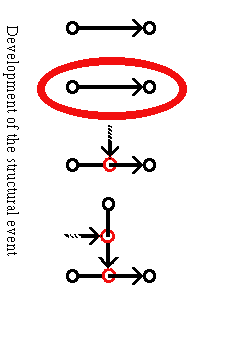
Extension:
The event becomes a location
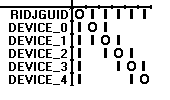 -- The form from device_1...
-- The form from device_1...
...develops into a new form.
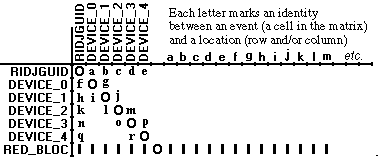
 -- start Kwik Tour
-- start Kwik Tour
Three Ways to Notate a Structure For Device_2 (Particular Example)
Events (grouped for display):
- (p-(a-v)) (p-(a-w)) (p-(a-x)) (p-(b-y)) (p-(c-w)) (p-(d-x))
- (q-(b-y)) (q-(c-w)) (q-(c-z)) (q-(d-x)) (q-(d-z))
- (b-v) (b-w) (b-x) (c-y) (d-y)
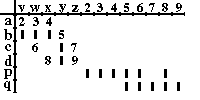
- The locations "p" and "q" are contexts where structural events are the details.
- Such locations are called "relations" because they resemble the mathematical object
of the same name.
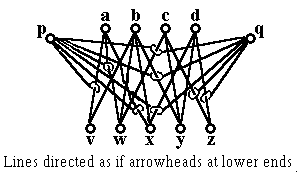 An interpretation of the structure:
An interpretation of the structure:
- Each location, a, b, c and d represents an internet service provider (ISP)
- Each location, v, w, x, y and z represents a customer
- A customer's use of an ISP is represented by an event, e.g. (a, v) means v@a.com.
- Each location p and q represents a mailing list
- A link between a mailing list and an (ISP - customer) event represents a presence on the list
(e.g., (p - (a-v) ) means that mailing list p is sent to v@a.com)
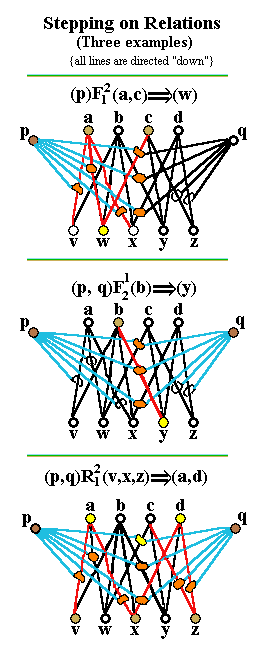
Development of Commands
The adjacent image illustrates the command "stepping on a relation":
Relations (such as p and q) are activated first; only those links activated through
the relations will be available for the command.
Interpreting the commands for the (mailing list - (ISP - customer) structure:
- Finding that w is the only customer that receives list p through both ISP a and ISP c

- Finding that y is the only customer that receives both list p and list q through ISP b

- Finding that ISP a and ISP d serve at least two of the three customers (v, x, z) that
receive either list p or list q
 -- Return to Kwik Tour
-- Return to Kwik Tour
Hardware: Adaptations of predecessor devices
Ways to implement Device_2:
- one "grand" design using device_1, with every data location and structural event entered
along the diagonal -- this is a complete and canonical design that
is sometimes conceptually useful but is needlessly large and cumbersome
- two interactive device_0 devices and two transfer devices (each uses a bank of switches and transfers
the settings from one kind of location to another, e.g. from contexts to details) -- most useful generally
- hierarchical design using several device_0 or device_1 systems-- this approach appears especially suited for some tasks, e.g., approaches to database searches
-- the (mailing list - (ISP - customer)) example would use 2 device_0 systems
and hardware for one transfer function
- conventional computers -- any particular structure and command set
can be emulated; however, combinatorial inflation is severe and the
programming obscures the concepts (a single device operation requires a complex
boolean statement).
Commands
A new system of device_2 commands
suggests approaches to systematic development of commands
including:
- Exploration of network structure (e.g., beginning with a specific context, find all 1st-order contexts (relations)
that include, as details, links from that context -- a half-step in and a whole step up)
- Stepping on relations (illustrated above)
- Explication of a location (systematic expression of detail and indirect detail)
- Explication of an isolated structure
- Exploratory explication based on relations
- Implication based on locations, structures and relations
- Neighborhood explication and implication
- Cluster-shaping
- Path-set definition and path-tracing
- Interface commands between ensembles
- Notation, storage and execution of device commands in compound form in anticipation of self-organization
according to forms of experience explored in stage_4 of Water Trail.
 -- (page
presently has no substance)
-- (page
presently has no substance)
Interpretation
An ordered triple of locations (event - (context - detail) is the initial element of structure.
Structures are assembled by identifications that superimpose
locations from different events:
- identifying two contexts (it is one book that has two different chapters)
- identifying two details (the same keyword appears in two sections)
- identifying a detail and a context (the chapter in the book contains a section)
- identifying an event and a detail (the link between two pages is an element in a structure of pages)
Generalizing the element of structure:
- invented contexts -- called virtual contexts --
that include details where linkage is desired (e.g. a context that includes as details
a document and the name of the document)
- identifications -- that collapse structure into smaller forms, more convenient to use
- generalized relations:
- using virtual contexts and identifications to construct a
form (relation - (term - term)) that supersedes (event - (context - detail))
- governed through
(category - instance) relations desecribed in
category
- the commands of device_2 are directly applicable
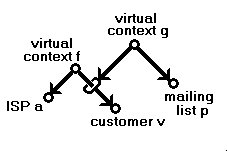
- E. g., a precursor form for the
( mailing - ( ISP - customer )) example
- virtual context f identified with ISP a
- virtual context g identified with mailing list p
Problems interpreted through notation developed in Stage 3 of Water Trail -- 
- Website design
- Legal research involving simultaneous searches on disparate search criteria
- Hypertext systems for consumer access to information
- Programming system to automate selection and sequencing of commands
operating the devices

Forward to Device_3.



All materials copyright by Robert Kovsky, 1997.


Mathematical Perspective
It appears to the author (not a mathematician) that the notation used for device_2 is contrary to
the rules imposed by
the theory of logical types. (Whitehead & Russell, Principia Mathematica, Introduction, Chapter II,
especially sections VI - VIII). The notation appears, therefore,
violative of mathematical structure.
Note that the rules for the assembly of
structures have no prohibition against (p-(q-r)) and (q-(r-p)) both appearing in the same structure; and the commands of device_2
navigate such a structure as any other.
The symbolic scheme attached to any particular example notated in the system can be re-organized to conform to type theory, but there
are conceptual elements (instance relations) where, in general, re-organization can require a number of levels
that becomes indefinitely large.
In contrast, the system of device_1 is clearly mathematical. The underlying structures
have been thoroughly investigated. See, e.g, Harary, Norman, Cartwright Structural Models: An Introduction
to the Theory of Directed Graphs (1965).
 -- Return to reference on this page
-- Return to reference on this page
Author's claim
to original design, including
instance relations (all in Guide to Ridge Route)




All materials copyright by Robert Kovsky, 1997.
 -- Guide to Ridge Route
-- Guide to Ridge Route



 -- The form from device_1...
-- The form from device_1...
 -- start Kwik Tour
-- start Kwik Tour
 An interpretation of the structure:
An interpretation of the structure:



 -- Return to Kwik Tour
-- Return to Kwik Tour -- (page
presently has no substance)
-- (page
presently has no substance)





 -- Return to reference on this page
-- Return to reference on this page